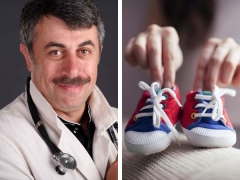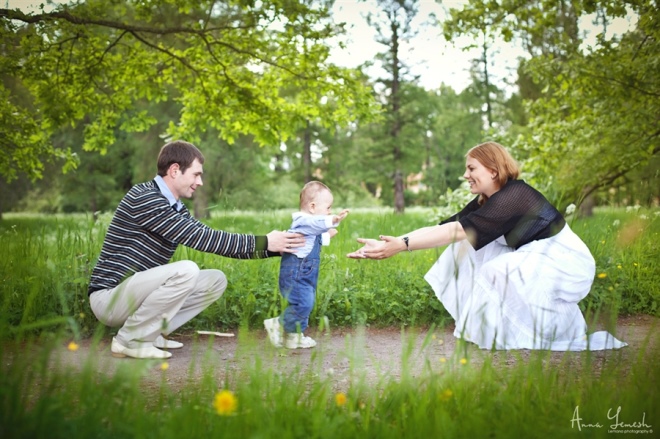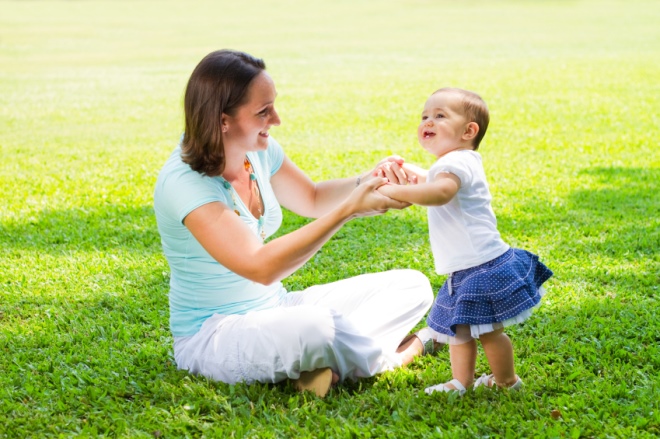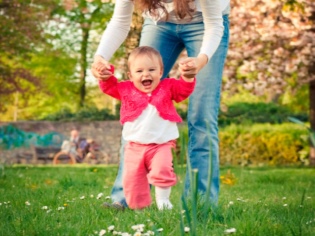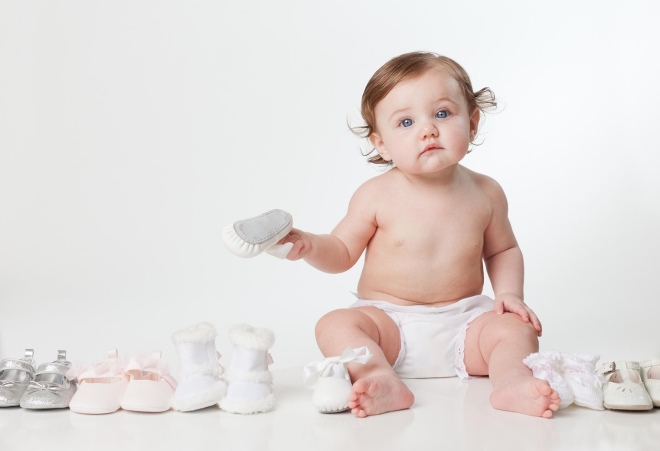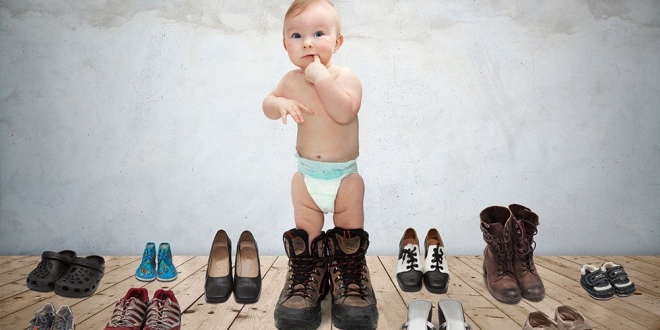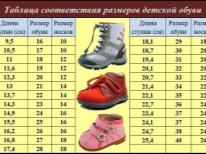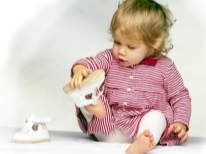Dr. Komarovsky on how to choose the first shoes for the baby
For the first steps of the crumbs, many parents begin to prepare in advance. And, having heard and read articles about the "terrible" flat-footedness and other problems that begin to "grow up" with the upright child, they wonder whether it is worth it to buy special shoes "for the first step". A well-known pediatrician, Yevgeny Komarovsky, tells whether a child who learns to walk should be shod and what should be the first toddler shoes.
Do you need shoes?
Yevgeny Komarovsky believes that a child can learn how to walk without shoes. Moreover, the foot of a person is created in such a way that he can only move barefoot. After all, no one is born in sandals or shoes! From the point of view of a natural approach, no special shoes are required for a child’s first step.
But when a child learns to stomp on his own two, he will have to gradually teach him to wear shoes.
After all to a kindergarten, for a walk or to the clinic, he will not go barefoot.
Parents should understand that shoes do not correct anything, and the arch of the foot will usually be what it is destined to be according to genetics. Footwear does not affect the straightness or curvature of the legs, whether the baby learns to walk faster or it will be slow in it. Footwear only protects the feet from cold and mechanical stress, and no more. And it is necessary to treat it from this position.
Barefoot or in sandals?
All children, without exception, are born with flat feet, i.e. flat feet have 100% of babies. The foot is formed as it grows and develops, and usually by the age of 12 it becomes clear whether there are flat feet or not. Dr. Yevgeny Komarovsky says that parents often blame themselves for flat-footedness, since from childhood they taught the child to wear slippers at home, sandals on the street.
The risk of developing flatfoot can be significantly reduced if you often give your child to walk barefoot. Houses on the floor - it should always be, and slippers - it's bad. It is very good if the child is there, where at least sometimes run barefoot except for his apartment.
It is great to release it with bare feet on the grass, on small stones, on asphalt, if you live in your own house and there is a yard area. In the summer, on holiday in the village with the grandmother, the child simply has to run barefoot. All this has a positive effect on the formation of the arch of the foot.
Fear of hypothermia is not necessary. Mom should not worry that a barefooted child who walks on the floor or on the ground will catch a cold. Legs are the only part of the human body whose vessels, when in contact with a cold surface, are able to constrict and thereby “save” heat, not to give it away to the environment. Walking barefoot is useful. And to sit in the cold - absolutely impossible, because the priests' vessels in a child do not know how to narrow.
Work to ensure that the foot was healthy, you need from an early age.
According to Komarovsky, parents do not need to rush things and specifically train their child to walk. Failure of the musculoskeletal system, muscles and ligaments, as well as the spine and feet, especially in plump toddler, can cause a variety of orthopedic problems. The child must take the first steps himself, without coercion from adults, and then when he will be fully prepared for this himself.
When are shoes needed?
Theoretically, the child’s shoes begin to be needed when he begins to leave the house “into people”. All babies who are starting to walk have an unsteady gait, their foot is not well developed. This can be partly explained by the limited functions of the children's ankle. From this point of view, it will be much more convenient for the child to take more confident steps in high shoes, which will fix and support the feet.
This does not mean that all parents of beginners "tramplers" should urgently run to the store for children's shoes with a high back and arch support. It is needed only for those children who walk erratically, often fall, and only in order to give them a little more stability and confidence. As soon as they find them, you can wear any shoes - with a low back, with a soft back, with anything, any model, as long as the baby is comfortable in it.
High and fixing shoes are harder, in theory, only for children under 3 years old. If it ceases to be necessary before - do not worry.
Orthopedic shoes
Orthopedic shoes are necessary for a child when an orthopedic doctor reveals certain problems, such as valgus feet, clubfoot, etc. These diagnoses must be confirmed by X-ray examinations. Only this gives the doctor the moral right to recommend mom to buy orthopedic shoes.
It often has to be made to order, taking into account the angle of curvature of the foot in a particular child. These parameters will indicate the doctor, and in the orthopedic salon will try to take into account all the doctor's prescription.
However, it is often possible to see how the parents of a completely healthy child go to buy him orthopedic shoes, very heavy, scary, ugly and expensive, but “terribly useful”. They do this as a preventive measure so that “there is no flat feet” and in order to avoid many other problems. And they often do this not on a whim, but because the doctor has advised.
Komarovsky is confident that as long as doctors in polyclinics receive a certain percentage of the profits of orthopedic stores and salons, this practice is and will continue to exist.
A healthy child who has not been given very specific diagnoses that require correction with the help of special therapeutic footwear does not need orthopedic shoes!
Inherited boots
Often parents are interested in whether it is possible to give shoes from an older child to a younger one. Komarovsky says that nothing terrible is that the baby will begin to stomp in the little shoes of his brother or sister, no.
If the shoe fits in size, does not crush and does not hang on the leg, if it is working, then you do not need to complicate anything. These are just clothes, and therefore it is possible to wear them after another child while observing the rules of hygiene.
How to choose the first shoes?
There are some simple rules, the knowledge of which will help parents choose the first, second, and each subsequent pair of shoes for their child, and at the same time do not harm him:
Do not buy shoes for growth. If the sandals are large, the rhythm of the gait slows down. In this, of course, there is no particular orthopedic harm, but still unpleasant. To compensate for the inconvenience of wearing large shoes, the child will begin to turn the socks inward, and the knees will often be bent when walking.
No need to purchase heavy shoes. This is especially true of winter and autumn shoes for the baby. The kid has just learned to stomp, and heavy high boots are brought to him, and besides, a caring grandmother will always wear a pair of woolen socks on the legs of a toddler before shoeing. To understand how a still wordless child feels, Komarovsky advises adults to put on ski boots and walk around them on a level road for at least half an hour without skis.
The model of the first shoe does not play a big role, says Yevgeny Komarovsky.If the child is healthy, he has no medical justified problems with the feet or the spine, then the main thing is not the color and the presence of laces or stickies, but convenience for the child.
But it is important that the socks are still round, narrow noses prevent the normal development of the fingers.
Shoes for toddler should be made of environmentally friendly materials. It is better to give preference to natural materials so that the foot in the shoes is not broken.
An ideal first shoe should be as stable as possible. The presence of a small heel is welcomed - it helps to develop the muscles of the foot faster. Hard heel will not allow the heel to "mow" to the side and roll up inside. A small and soft insole instep will unobtrusively maintain the arch from the inside.
Do not buy too hard shoes (shoes, sandals), because soft shoes do not create artificial obstacles to the development of the foot.
Pay attention to the sole. It should not be too slippery or too soft. In such shoes, the risk of falling to a baby is higher.
Learn more about how to choose shoes for your baby, you will learn from the following video.
